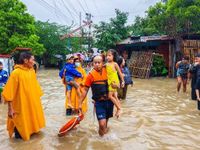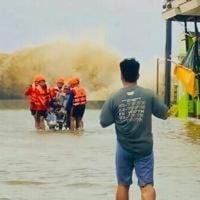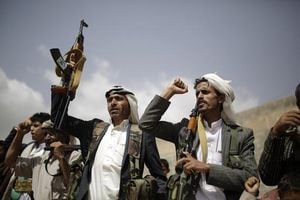As Tropical Storm Bualoi swept across the central Philippines in late September 2025, communities already battered by a season of relentless typhoons found themselves once more in the path of disaster. The storm, which made landfall in the town of San Policarpo in Eastern Samar province on September 25 with sustained winds of 110 kilometers per hour, unleashed a wave of destruction that left at least 11 people dead, forced the evacuation of over 430,000 residents, and exposed the frailties of the country’s disaster preparedness amid a deepening political scandal.
According to the Philippine disaster-mitigation agency, Bualoi—locally called Opong—was the fifteenth tropical cyclone to hit the archipelago this year. Its arrival was particularly ill-timed, coming just days after Super Typhoon Ragasa, one of the strongest in recent memory, had claimed at least 14 lives in the northern Philippines and Taiwan before dissipating over Vietnam. The back-to-back storms have amplified humanitarian concerns, especially for those living in flood-prone and impoverished regions, as reported by The Inquirer and confirmed by the Office of Civil Defence.
In the immediate aftermath of Bualoi’s landfall, power outages swept across east-central provinces, and the storm’s 450-kilometer-wide rain and wind band triggered flooding and at least two minor landslides. The central island province of Masbate was among the hardest hit, with four deaths reported on September 25—three people killed by a falling tree, a collapsed wall, and falling debris, and a fourth struck by lightning, according to local officials cited by the Associated Press. In the nearby islands of Biliran and Ticao, the toll was even more severe. Provincial disaster official Noel Lungay told AFP, “There was widespread flooding and some roads remained under water early today. Evacuees are starting to return to their homes as the weather improves.”
By September 27, the official death toll had climbed to 11, with eight fatalities in Biliran alone and two people still missing. Fourteen individuals remained unaccounted for across the central Philippines, as search and rescue operations continued in the storm’s wake. More than 200,000 people were still sheltering in evacuation centers, even as the weather began to clear in some areas, according to the Office of Civil Defence in Manila.
Pre-emptive evacuations played a crucial role in limiting casualties. Authorities had moved more than 433,000 people—spanning 120,888 families—into government emergency shelters, including schools, gyms, and municipal buildings repurposed as safe havens. In Albay province, where the active Mayon volcano looms, villagers living on its foothills were specifically urged to relocate due to the risk of volcanic mudflows triggered by heavy rainfall. “We need clearing operations because most of our road networks are not really passable for food and health assistance to pass,” Masbate Governor Ricardo Kho said at a news conference, highlighting the logistical challenges faced by relief teams. “We also need help to have our ports reopened as early as possible for us to receive help from different provinces.”
Despite these efforts, the storm’s impact was deeply felt. Bualoi toppled trees and power pylons, ripped roofs off homes, and left many roads blocked, complicating the delivery of relief supplies. Flooding was especially severe in Bulacan province, where residents had already been coping with heavy rains from previous storms. The Philippine News Agency reported that relief operations were further hampered by impassable roads, while disaster officials warned that more flooding and landslides could occur in the coming days.
As Bualoi moved northwest, it maintained typhoon strength, with winds reaching 120 kilometers per hour as it crossed the South China Sea toward central Vietnam. The Philippine state weather service forecast that the cyclone would reach Vietnam’s coast by September 28, potentially restrengthening before landfall. The rapid succession of storms was a stark reminder of the Philippines’ vulnerability: situated in the path of the Pacific typhoon belt, the country is struck by an average of 20 storms and typhoons each year. Scientists, as cited by AFP, warn that these storms are becoming more intense as global temperatures rise, a trend driven by human-induced climate change.
Yet, as communities struggled to recover from the physical devastation, another storm was brewing—this one political. Multiple investigations had implicated lawmakers, including allies of President Ferdinand Marcos Jr., in a corruption scandal involving flood control and infrastructure projects. The allegations, which included claims of massive kickbacks financing lavish lifestyles, ignited public outrage and protests across the country. President Marcos did not mince words, describing the scale of corruption and its impact on ordinary Filipinos as “horrible.”
The consequences of this scandal were not merely financial; they undermined the very infrastructure needed to protect the public from disasters like Bualoi. Two dismissed government engineers testified before a Senate inquiry that most flood control, road, and other infrastructure projects in Bulacan—a province of 3.7 million people—were either substandard or overpriced to compensate for bribes paid to congressmen and senators. As a result, communities found themselves repeatedly exposed to the dangers of flooding and landslides, with little faith in the systems designed to protect them.
The public’s frustration boiled over into mass demonstrations. According to AFP, thousands took to the streets on September 28 to demand accountability, with peaceful protests later giving way to clashes that saw police vehicles set on fire and the windows of a precinct headquarters shattered. The anger was palpable, fueled by the sense that taxpayer money meant for disaster resilience had been squandered, leaving the most vulnerable at risk.
Meanwhile, humanitarian needs continued to mount. With more than 430,000 people displaced, many repeatedly so in the wake of back-to-back storms, relief agencies faced the daunting task of providing shelter, food, and medical care to those in need. The Philippine News Agency and The Inquirer both noted that temporary shelters were stretched thin, and the psychological toll on communities—especially children—was becoming increasingly evident.
As Bualoi moved on toward Vietnam, the Philippines was left to reckon not only with the immediate aftermath of another deadly storm but with deeper questions about governance, accountability, and the country’s long-term resilience to the forces of nature. For many, the hope is that lessons learned from this season of storms will translate into real reforms—so that, next time, the country will be better prepared to weather both the literal and figurative tempests it faces.





